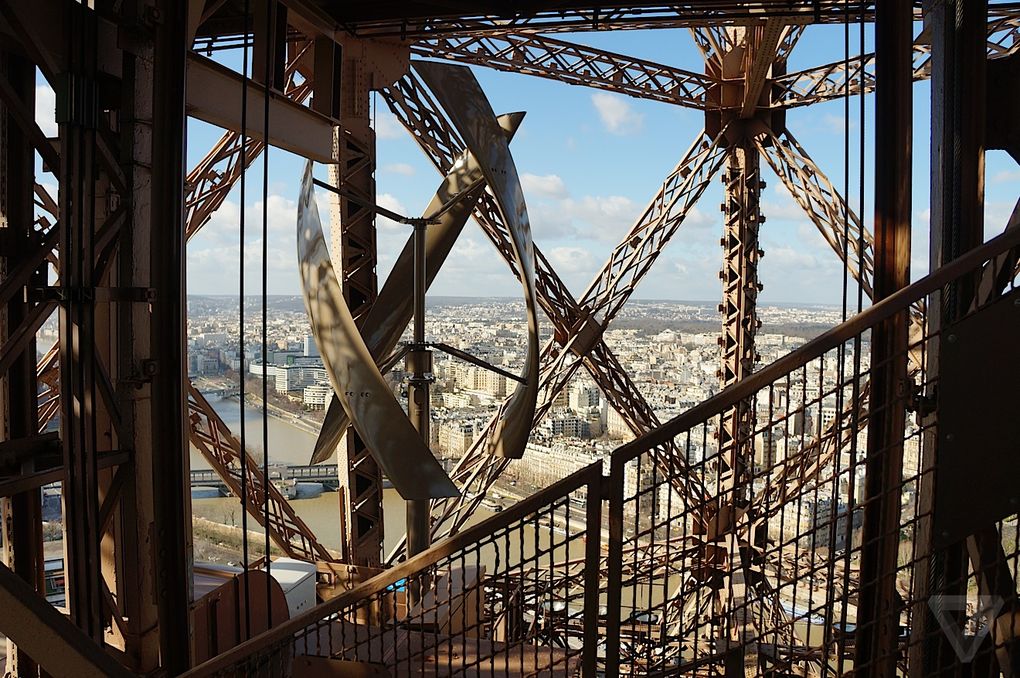New wind turbines make Eiffel Tower more beautiful.

March 05, 2015 | posted by The Institute
Source: theverge.com

By: Amar Toor
The Eiffel Tower’s iron-clad frame turned slightly greener last week, with the installation of two new wind turbines along its lower deck. Perched some 400 feet above the ground, atop a ritzy, second-level restaurant, the slender turbines are part of a broader effort to make Paris’ most iconic monument more eco-friendly — even if only slightly.
When they go into operation next week, the 17-foot structures will provide enough electricity to power the tower's first-floor commercial areas — about 10,000kWh per year. Jan Gromadzki, an engineer who oversaw the project for New York-based Urban Green Energy (UGE), says that's enough to power an average American family’s home for one year. But for the Eiffel Tower — which consumes an estimated 6.7 GWh a year — “it's just a small drop in the ocean."
"A VISUAL STATEMENT"
"This installation is definitely more symbolic," Gromadzki says. "But it is still significant because the merchant spaces on the first floor do consume energy, and being able to offset that consumption is something people can really assimilate and understand."
The curved, tri-blade turbines were designed and installed by UGE, which has planted its crescent-shaped turbines and other renewable systems at sites across the globe. But the Eiffel Tower posed unique challenges. Each blade had to be hoisted by hand and pulley up to the second floor, and secured within the building's tight lattice structure along its southwest corner. The entire installation had to unfold at night, as well, since the Eiffel Tower is open to the public until 11PM seven days a week.
The Société d'Exploitation de la Tour Eiffel, the organization that manages the Eiffel Tower, wanted "something that would make a visual statement," Gromadzki says, without distracting from its distinct silhouette. So the blades were painted in a brown-grey hue to match the building, and extra vibration dampeners were added to make sure the turbines wouldn’t disturb diners at the upscale Jules Verne restaurant below. When running at full speed, the turbines only produce about 40 decibels of sound — about the equivalent of a whisper.
When the turbines are moving, they’re clearly visible from the Trocadéro square, which offers a direct view of the tower from the opposite side of the Seine. But from the foot of the tower looking up, they’re barely visible, lost amid the lattice maze of iron that holds everything together. Up close, they look sloped, smooth, and far more elegant than the utilitarian propellers usually associated with wind power installations.
UGE's turbines are the latest in a series of clean energy additions for the Eiffel Tower, which attracts an estimated 7 million tourists per year. The 125-year-old tower is in the middle of a two-year, €30 million ($33.6 million) renovation that will add energy-saving LED lights and an array of solar panels to heat half of the hot water it uses. (The renovation also introduced a vertigo-inducing glass floor on the tower's first level.)
A "BIG LEAP FORWARD FOR RENEWABLE ENERGY."
Paris has also embraced greener policies in recent months, ahead of hosting a global summit on climate change in December. The city recently called for all municipal buildings and public lighting to exclusively use electricity from renewable sources by the year 2016, and Mayor Anne Hidalgo wants to ban all diesel vehicles from Paris by 2020, in the hopes of easing its smog problems. The hope is that planting discrete wind turbines on the city’s most recognizable building will not only reaffirm Paris' eco-friendly agenda, but spur others to adopt similar technologies, as well.
"It really does represent this big leap forward for renewable energy as a whole, to have this technology to the point where it can be easily adopted by consumers like the Eiffel Tower," Gromadzki says. "And I think that was something that, five years ago, no one would've been ready for. It demonstrates that we’ve come this far to create renewable energy technologies that can be easily integrated into the daily lives of people around the world."








